04
2024
-
12
Chip-level computational reconstruction near-infrared spectral sensor
Author:
Micro-spectrometers show great potential in in-situ, in vitro, and even in vivo sensing applications. However, the significant performance limitations brought about by the reduction in size make it difficult to meet the stringent demands of spectroscopy (high resolution, high precision, and ultra-wide operating bandwidth). It is widely believed in the industry that micro-spectrometers are more suitable for rough identification of characteristic peaks. In recent years, the emergence of computational reconstruction spectrometers based on compressed sensing algorithms has opened new avenues for the development of micro-spectrometers. Figure 1 summarizes the comparison between near-infrared spectroscopy demands and the performance of computational reconstruction spectrometers.
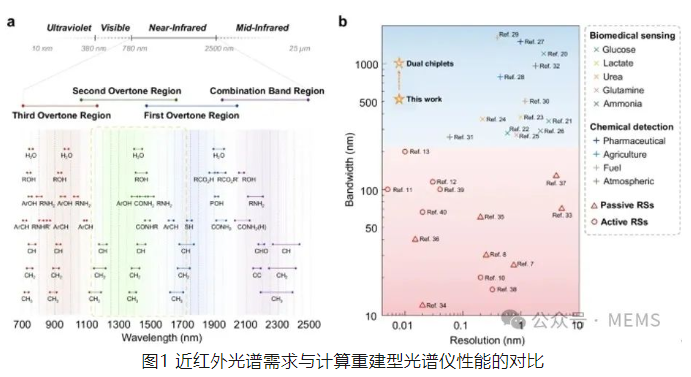
According to a report by Mems Consulting, a joint research team from the University of Cambridge and GlitterinTech Limited has recently proposed an integrated computational reconstruction spectrometer that supports near-infrared (NIR) spectral measurements, showcasing a fully packaged sensor with auxiliary electronic components. This sensor operates over a bandwidth exceeding 520 nm, with a resolution of less than 8 pm, and a bandwidth-to-resolution ratio exceeding 65,000, setting a historical record. Research indicates that this sensor can classify different types of solid materials and measure the concentration of aqueous and organic solutions with an accuracy close to 100%. Notably, the detection limit for glucose solution concentration has reached the level of commercial benchtop spectrometers, as low as 0.1% (i.e., 100 mg/dL). This research result was published under the title 'Chip-scale sensor for spectroscopic metrology' in Nature Communications.Nature Communicationsjournal.
Computational reconstruction spectrometers require a sufficient number of sampling channels that exhibit rapid and random spectral perturbations (also known as spectral speckles). To meet this demand, researchers designed an ultra-wideband single-bus computational reconstruction spectrometer based on a cascaded dispersion-engineered micro-ring resonator (MRR), as shown in Figure 2a. This device utilizes a silicon nitride (SiN) platform, benefiting significantly from its material dispersion characteristics, which are over four times lower than that of silicon on insulator (SOI). Figure 2b shows a structural diagram of the vertical runway micro-ring resonator. The key to this micro-ring resonator design is to maintain a balance between loss and coupling efficiency over as wide a wavelength range as possible. The simulation results of this device are shown in Figures 2d to 2f, indicating that this design can efficiently generate a spectral sampling matrix with thousands of temporal channels.
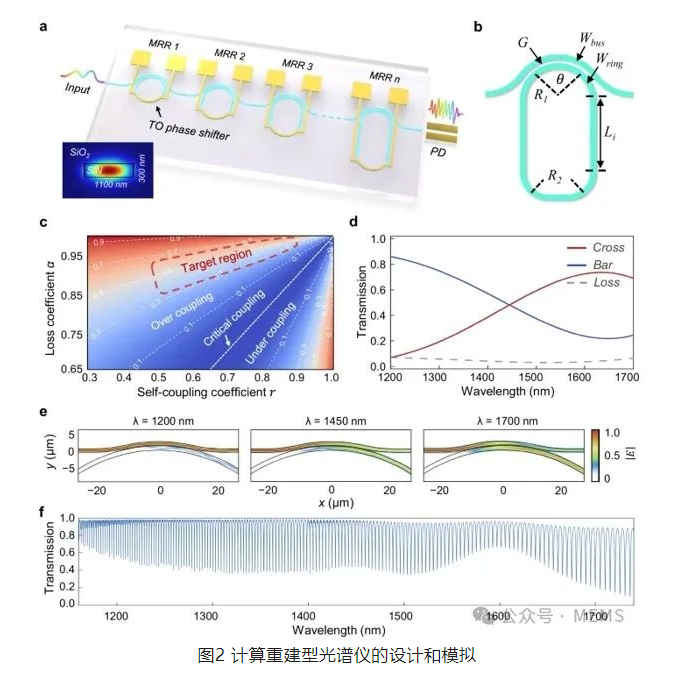
Figure 3a shows a fully packaged centimeter-scale near-infrared spectral sensor, which integrates the SiN reconstruction spectrometer chip and a high-speed driver board with a microcontroller unit (MCU). The design of the computational reconstruction spectrometer chip integrates six cascaded micro-ring resonators, which is the result of optimizing the balance between device performance, system footprint/complexity, and sampling channel consumption.
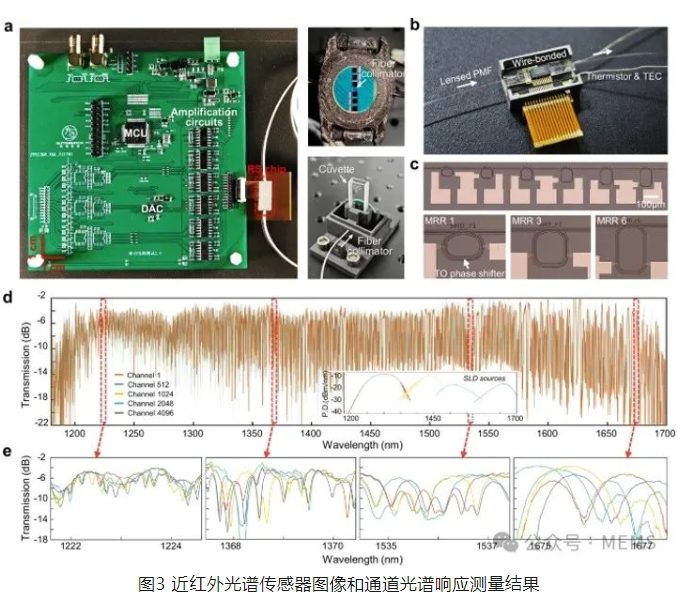
To characterize the performance of the computational reconstruction spectrometer, researchers first tested various discrete incident spectra, including single-peak, double-peak, and triple-peak laser signals of different wavelengths. As shown in Figures 4a to 4c, this computational reconstruction spectrometer can accurately resolve the intensity and position of all peaks, with a relative error very low, ranging from 0.04 to 0.11. Notably, the spectral spacing of the double-peak signal gradually shrinks to 8 pm, which can be marked as its resolution according to the Rayleigh criterion.
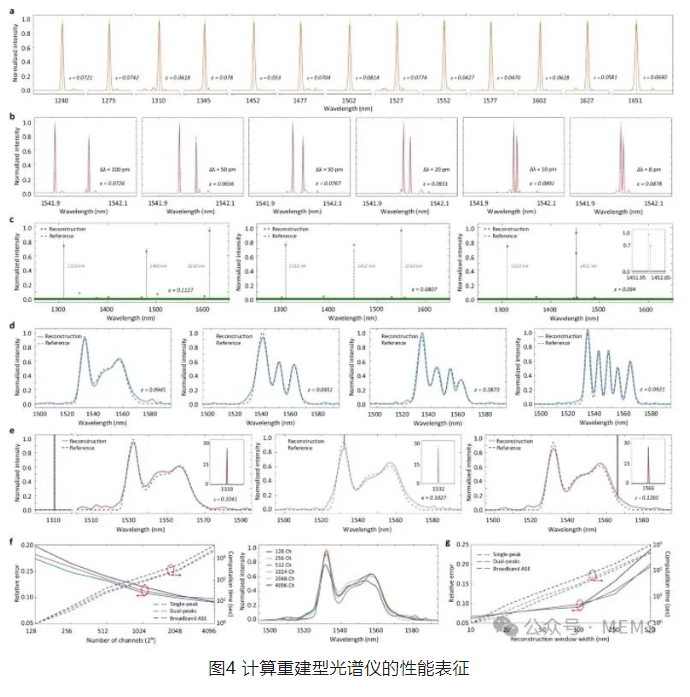
Finally, researchers used the fully packaged near-infrared spectral sensor for spectral applications with stringent bandwidth requirements, such as material classification and solution concentration monitoring, meeting typical industrial demands. (1) Researchers tested ten common plastics in chemical production and ten types of coffee from different regions. Figures 5a and 5b show the measured reflectance curves of the two representative samples of plastics and coffee, respectively. Figures 5c and 5d display the classification results of the plastic and coffee samples, both achieving an accuracy of 100%. (2) Researchers tested ethanol aqueous solutions, ethylene glycol (EG) in isopropanol (ISO) solutions, and glucose aqueous solutions, with the relevant test results shown in Figure 6.
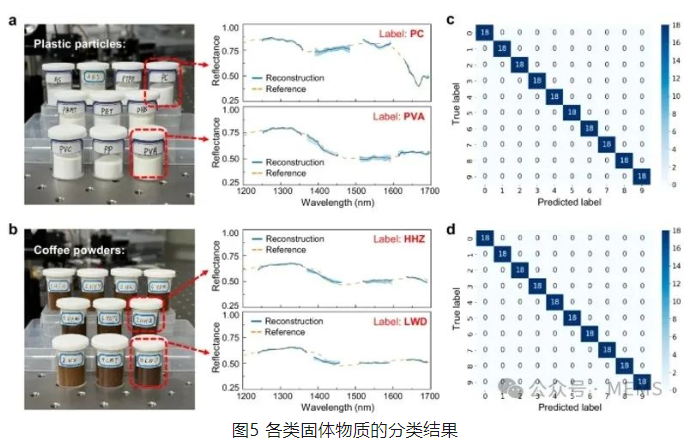
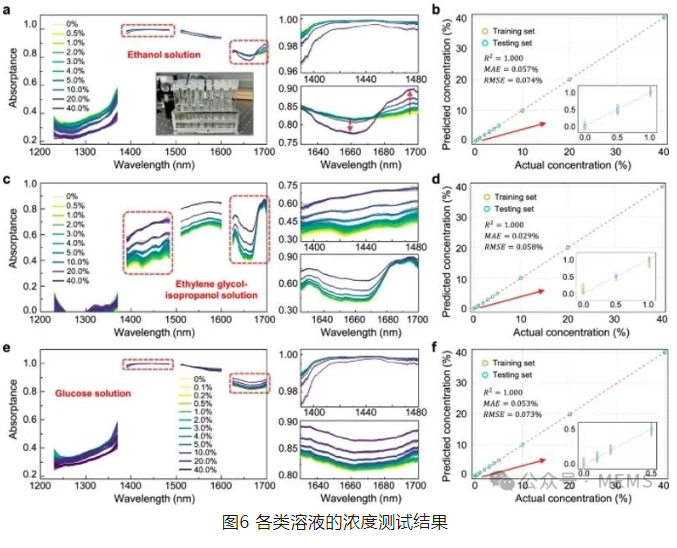
In summary, this research developed a computational reconstruction near-infrared spectral sensor, achieving outstanding performance with an operating bandwidth exceeding 520 nm and a resolution of less than 8 pm. The study also explored various spectral applications of this chip-scale spectral measurement sensor, with results indicating an accuracy close to 100%. Solution concentration tests demonstrated that the detection limit of this device is as low as 0.1% (i.e., 100 mg/dL), a performance comparable to commercial benchtop spectrometers. This research achievement marks a significant advancement for micro-spectrometers in spectroscopic metrology.
LATEST NEWS
2025-01-09
Design and Development of Full-Spectrum Photodetectors
In recent years, the booming optoelectronic industry has changed the world and extended into many aspects of life. Among them, photodetectors (PDs) with a wide response bandwidth from deep ultraviolet to visible to near-infrared serve as important optoelectronic components and play a key role in daily life.
2025-01-08
Black arsenene multi-spectral integrated field-effect transistors, aiding high-resolution imaging and enhanced secure communication.
With the development of modern communication technology, the demand for broadband, room-temperature infrared, and terahertz (THz) detectors has rapidly increased. These detectors play a crucial role in fields such as telecommunications, security inspection, non-destructive testing, and medical diagnostics. However, existing optical detectors face challenges such as high intrinsic dark current and the need for low-temperature cooling, which limit their efficiency in detecting low-energy photons. Particularly in the terahertz band, the photon energy is insufficient to excite electron transitions from the valence band maximum (VBM) to the conduction band minimum (CBM), making effective optoelectronic conversion difficult. Therefore, researchers have been seeking ultra-broadband detectors that can operate at room temperature and respond to wavelengths ranging from visible light to the terahertz band.
2024-12-30
Laser-based tiered neurons achieve high-speed reservoir computing.
Neuromorphic computing is a computational paradigm that simulates the functions and architecture of biological neurons. A single biological neuron is a powerful computational unit with information processing capabilities, information transmission abilities, and memory functions. Therefore, it is crucial to design a photonic neuromorphic processor that can truly emulate the powerful computational functions of biological neurons.
2025-01-01
Design and Development of Full-Spectrum Photodetectors
In recent years, the rapidly growing optoelectronic industry has changed the world and extended into many aspects of life. Among them, photodetectors (PDs) with a wide spectral response from deep ultraviolet to visible to near-infrared serve as important optoelectronic components and play a key role in daily life.
2024-12-31
High-sensitivity quantum dot photodetectors from deep ultraviolet to near-infrared
In recent years, the rapidly growing optoelectronic industry has changed the world and extended into many aspects of life. Among them, photodetectors (PD) with deep ultraviolet-visible-near infrared full spectrum detection response serve as important optoelectronic components, playing a key role in daily life.

